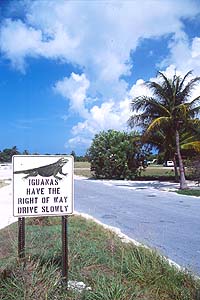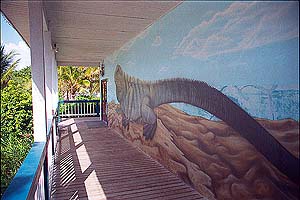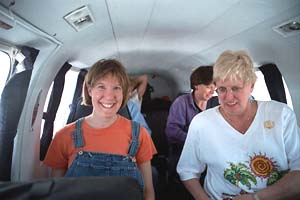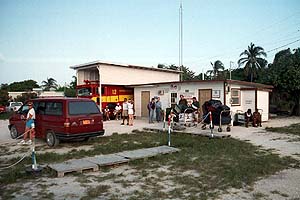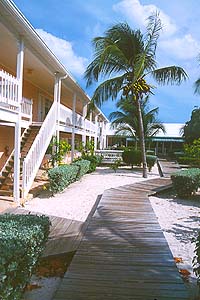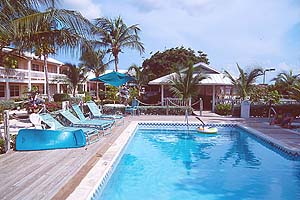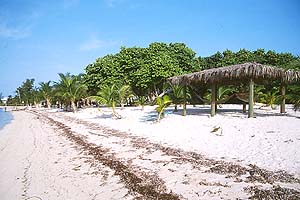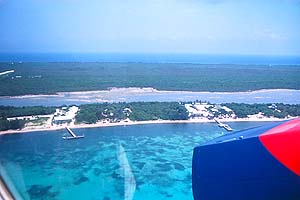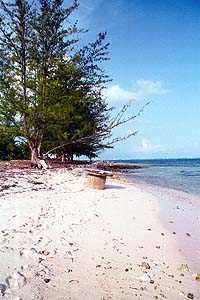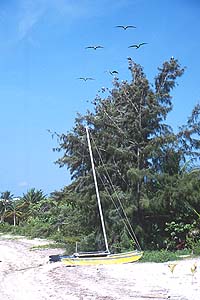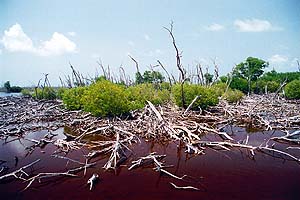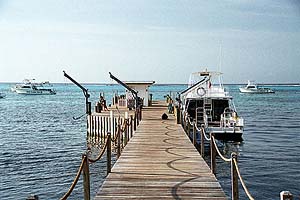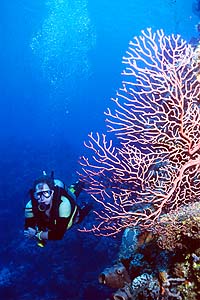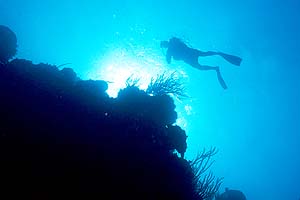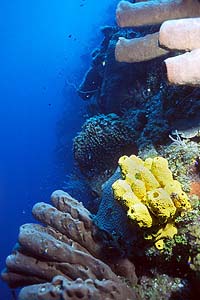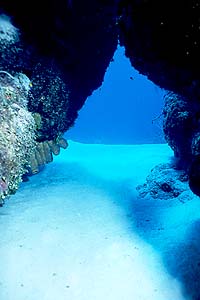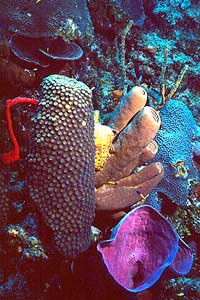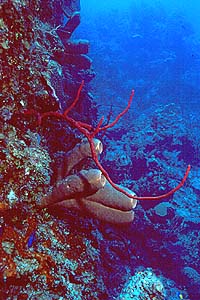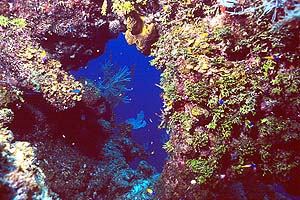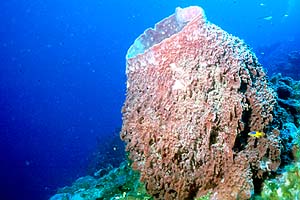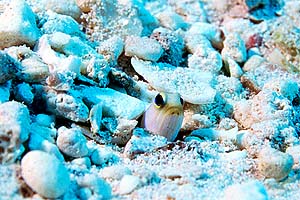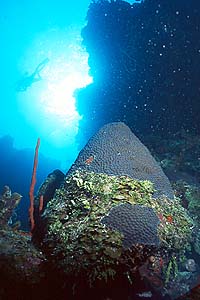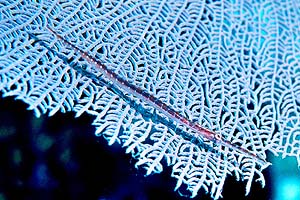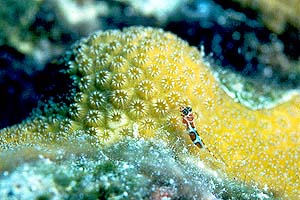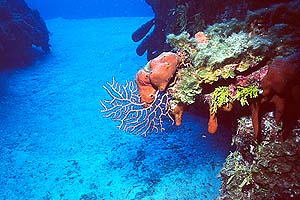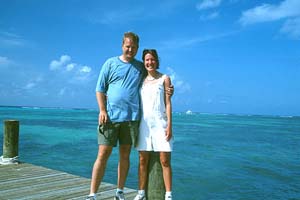Little Known, Little Visited: Little Cayman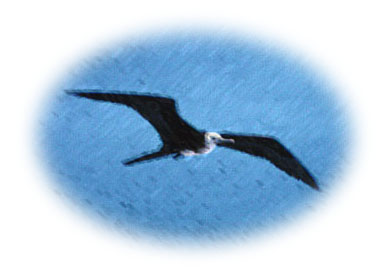
Text and images Copyright (C) 1999 David M. Read My wife and I, along with two friends, went on a one-week trip to the Little Cayman Beach Resort from Saturday June 26 to Saturday July 3, 1999. This is a report of that trip. All of the images below are hyperlinks. Click on any image to see a larger version. |
Tell someone who isn't a diver that you're going to Little Cayman, and you will almost invariably get a blank look and a "where?" in response. Tell a diver who hasn't been there, and you'll get a wide-eyed "really? I've heard great things about it!" Tell a diver who has been there, and you'll get a set of glazed eyes as they drift off, remembering the beauty and isolation of the remote Caribbean destination.
Little Cayman is a tiny slip of land approximately 70 miles from Grand Cayman, and just 5 miles from its nearest neighbor, the sister island of Cayman Brac. As a group, the Cayman Islands are less than 100 miles south of Cuba in the Western Caribbean.
As far removed in culture and development from Grand Cayman as Cayman Brac is, Little Cayman is farther still. The Brac hosts upwards of 1200 permanent residents on the 12-by-one-mile island, but Little Cayman's 7 square miles are home to just 100 people. Cayman Brac has several restaurants, a relatively well-stocked grocery store, a jet airport, and even a building-supply depot.
|
Little Cayman has one restaurant ("The Hungry Iguana"), a
tiny--but packed-- general store, and a bare patch in a grass field for an airport. A sign
near the airport proclaims "Iguanas have right of way. Drive Slowly." But despite the bucolic appearance of Little Cayman, one wonders if change isn't lurking around the corner. A circumnavigation of the island in one of the loud and cantankerous rental jeeps shows that just about every existing house on the island is for sale, and that every undeveloped piece of land has been surveyed and sectioned off into lots. Someone has big plans for this little piece of paradise. But remoteness is only part of what brings travellers to Little Cayman. The largest part of the attraction is scuba diving. Divers flock to Little Cayman from all over the Americas. They come seeking pristine, undamaged reefs. They come seeking the turtles for which the Cayman Islands were originally named (Christopher Columbus proclaimed the islands "Tortugas"). But mostly, divers come to Little Cayman seeking the "walls," the vertical drop-offs where the shallow reef disappears into the 6,000-foot depths of the Cayman Trench. And Little Cayman will never disappoint these bubble-blowing thrill seekers. |
Indeed, Little Cayman's reefs are as healthy as any in the Caribbean, although that doesn't mean as much in 1999 as it did in previous years. Many, if not all, of the Caribbean reefs are under great stress due to elevated water temperatures. These high temperatures, as high as 88F in some places, lead to coral bleaching and rapid algae growth. Unfortunately, Little Cayman's reefs are suffering the same fate as many other Caribbean reefs: some of the coral color is departing due to the bleaching, and parts of the reef are over-run by algae growth, which chokes off light and nutrient flow to the coral. The sponges still seem healthy, but in places, Little Cayman's reefs are in trouble (see Great Wall West, below). |
|
Little Cayman, like many other popular Caribbean diving destinations, has declared a large portion of its reef as a marine park, dedicated to the preservation of the resources which attract so many travellers. No fishing is allowed, nor collecting of any kind, nor harassment of the marine life. The only exception to the harassment rule relates to the grouper population, several of which are friendly, and seem to enjoy being petted by divers. Little Cayman's preservation efforts are clearly working, as we saw more grouper (and larger, older, grouper, too) than we had seen on any other dive trip. We also saw an incredible number of queen trigger fish, more than we had seen in all our previous dives combined.
Getting There
| Getting to Little Cayman is, frankly, a pain in the butt. There's really
only one way on or off the island, namely an Island Air flight from Grand Cayman (possibly
connecting through Cayman Brac). Island Air owns exactly two aircraft, a DeHaviland Twin
Otter, and a Piper Navajo. The Otter seats something like 20 passengers, while the Navajo
seats just 10--and then only if one of the passengers sits in the copilot's seat!
Surprisingly, the flights to and from Little Cayman are sort of fun, half school-bus ride,
half roller coaster. Landings are amazingly gentle. But the problem with flying Island Air is not their aircraft or even their somewhat fluid schedules. The problem is their milk-the-customer attitude. When we arrived on Grand Cayman, we were running about 3 hours behind schedule due to weather delays in leaving Miami. We had planned for a 3.5-hour layover on Grand Cayman, so the 3-hour delay was not too worrisome...until we arrived at the Island Air counter, just under 30 minutes before scheduled departure. The counter was unmanned. |
|
Finally, when an Island Air agent appeared again (half an hour later, about 45 minutes before the next scheduled departure), we were told that we would have to pay a $25 per person fee for missing our flight, in addition to $0.50 per pound in excess-baggage fees (which we expected, and were prepared to pay). The fee was imposed despite the fact that the missed flight was not our fault, and despite the fact that Island Air sold our seats on the missed flight to other customers--the flight left fully loaded! Needless to say, I was outraged. But Island Air is the only game in town if you want to get to Little Cayman, so I grimaced and paid the ransom.
On the way back from Little Cayman, we were again charged an excess-baggage fee (again, expected), but this time they nicked us for $10 per person because we couldn't find our tickets. The 8x10 computer-printed manifest on the agent's desk clearly showed our names at the top of the list, but still we were charged another $20--for nothing. No passenger was given a boarding pass, and we in specific were not actually given anything more than a receipt for $20.
So Island Air held us up for another $70 in total. I would have preferred for our tickets to just cost $35 apiece more than to be robbed like this. As I wrote in a letter to Little Cayman Beach Resort, "I will never ever return to Little Cayman so long as Island Air is the only way to get there." I would advise anyone thinking about travelling to Little Cayman to think twice, and carry extra cash for the air bandits at Island Air.
The Resort
|
We stayed at the Little Cayman Beach Resort, a wonderful resort on the windward side of the island. They have roughly 40 air-conditioned rooms, along with a tennis court, a swimming pool, a great restaurant, a palapa-covered bar (of course), quite a stretch of beach, and diving facilities. The rooms are sparsely furnished but spacious and comfortable. Let's be serious: you're there to dive, so do you really care how pretty the rooms are? My wife complained of a foul odor in the bathroom, but I was barely able to detect it...either way, the second-floor rooms have carpeted floors, which are much nicer than the tiled floors on the first floor. Our tiles were always slippery and somewhat slimy from the humidity. The food at LCBR is, in a word, spectacular. I can't remember all of the fantastic dinners we enjoyed, but I do recall a night of roasted lobster tails, another night of wonderful seafood lasagna, and an ever-changing assortment of irresistible desserts. I don't want to know how much weight we gained that week. |
Meals are served promptly, and the line of hungry and expectant guests forms quickly. Drinks include iced tea, lemonade, some sort of fruit punch, and milk (at breakfast). Breakfasts included eggs, pancakes, sausage, cereal, and just about everything else the average American would consider "normal." Lunches featured cold cuts, soups, and various hot entrees.
|
Topside
Little Cayman doesn't boast the wealth of non-diving topside activities that some diving destinations do, but there are a few things wort doing on the island. There's the famous booby pond, which is a protected nesting area for the red-footed booby. There's semi-famous Tarpon Lake which is known to fishermen, and there is some game-fishing available offshore. Mostly, though, the island offers a fair amount of beautiful scenery.
|
|
The Dive Operation
| We used LCBR's in-house dive operation (Reef Divers), of course, and
ended up with somewhat mixed feelings about the operation. The boats (Newton 42s) were
generally large and comfortable, and had camera tables, but there were no rinse tanks for
cameras (an important feature to me). A fresh-water hose had to suffice, and while it was
better than nothing, it's still not as good as a rinse bucket. The big problem with the dive operation is that all of us felt that the operation was designed for the convenience of the staff, not the needs of the customers. |
|
For instance, when you check in with the dive shop, you are assigned to a particular boat. This doesn't sound problematic, but in our case, our boat left dock dead last on every dive except one. That meant that we got the worst choice of dive sites every dive. My choice would have been to assign each boat to a particular dive site (with the understanding that the site might be taken), and then let the divers choose which boat (and hence which site) they wanted to dive.
| Worse still, dive schedules were fixed: 100 feet for 45 minutes on the
first dive, 60 for 50 on the second. These profiles left me getting out of the water with
four green pixels to go on my computer--and I was diving nitrox, while my computer was an
air-only unit! There was no provision for nitrox divers, despite the availability of
nitrox through the dive shop. Continuing with my gripes: apparently the resort is allowed to send its boats into the marine park only once per day...so the afternoon dive is always conducted outside of the marine park. Frankly, the out-of-park dive sites are unbelievably dull when compared to the in-park sites. After two days, our group quit doing the afternoon dives. |
Given that scenario, it would have made more sense to designate one or two boats as "nitrox" boats; those boats would take nitrox divers for longer dives inside the marine park, with the under-standing that no afternoon dives would be possible. I would have greatly preferred to do two hour-plus dives in the marine park rather than two short dives in the park and a third outside the park. With nitrox and my (admittedly 'average') air consumption, I could have done 100/1:00 and 60/1:20 easily. 100/1:15 and 60/1:30 wouldn't have been a stretch, for that matter. I understand that there are logistical issues with my suggestion, particularly where the dining room is concerned...but these are problems to overcome, not ignore.
More problems with their routine: when ready to dive, they ask you to move to the swim step, put on your mask & fins, and wait for them to bring you your rig, which they help you don. Then you stand up, grab your reg, and do your giant stride. Before each dive, the staff set up your gear for you.
I have a number of problems with this setup. First of all, I don't like to have other people assembling my gear; I prefer to do it myself. But more importantly, there is a subtle pressure to stand up & do the entry quickly. So in effect, they're asking you to trust that someone else has assembled your gear correctly, and then to enter the water without sufficient time to double-check the setup. Worse, there is absolutely no way to perform a buddy check with this routine.
| Twice I found my tank unchanged between dives--I caught it both times, as
I insisted on checking my gear before they brought it to me. I can't count how many times
I saw divers enter the water without their weight belts. Basically, this routine is a safety nightmare. When I mentioned my preference for rigging my own gear, donning it myself from the benches, and making my own unassisted entry, I was asked (somewhat curtly, too) to stick with the designated routine. Then there was the dive staff. Some were friendly and outgoing (Jim Viers springs to mind), while some were withdrawn and slightly arrogant, and others still...well...Here's the story. |
On one of the dives, I was slightly bored because the dive site was generally devoid of living coral, having been overrun with algae. I found a Christmas Tree worm, one of my favorite underwater friends. As I watched, the worm's gills retracted as they do, and I decided to wait and watch the re-emergence. A very mild current was running, and since the worm will not re-appear if it senses nearby predators, I found a piece of dead star coral and latched on with a gentle thumb-and-forefinger grip. Folks, this coral was dead. It was completely white (not the ghostly white of living albeit bleached coral, but the chalky white of long-dead coral), and many of the skeletons were obviously crushed in. This chunk was dead.
A little while later, a diver swam up to me, slapped my hand, and started shaking her finger at me. I pointed to the dead coral and made the out-of-air "it's dead" signal, figuring that this obviously new diver didn't know dead coral from living coral. She shook her head "no," so I pointed to the exact section I had been touching and made the "it's-dead" signal again. Again, a "no" headshake from the other diver...so I gave up, figuring that I could explain it to this person back on the boat. I waved her off with a two-handed sweeping motion, snagged my handhold again, and went back to waiting for the Christmas Tree worm to reappear.
Again, she slapped my hand and shook her finger at me. Again, I waved her off...a little more pointedly this time: "you" --"swim" -- "over there." She refused to leave me alone, and I figured that with all the disturbance, the Christmas Tree worm would be slow to appear, so I gave up and swam off.
I was somewhat dreading getting back on the boat, as I figured this idiot newbie would be in my face. Don't get me wrong, most newbies are not idiots, but there are some who think they know everything...and don't. Regardless, the confrontation on the boat was worse than I could have imagined. It turns out that the idiot newbie was actually one of the boat divemasters. As I broke down my gear, she walked up to me in the crowd of divers on the boat, and said in a voice loud enough for everyone on the dive deck to hear, "Dave, if you're having trouble with your buoyancy, I'd be happy to work on it with you."
Clearly she was feeling confrontational, and I was somewhat stunned by the incredible rudeness and lack of professionalism. I was so surprised that I was unable to convince myself to speak the retort on the tip of my tongue ("xxx, if you're having trouble being basically polite to your customers, I'd be happy to work on it with you") ...So I tried to defuse the situation, explaining that the coral I had been touching was long dead. She replied that it was alive, and that I had been killing the reef by touching it. I explained how I knew it was dead, and yet still she persisted. Ugh.
OK, here's the problem: if you as a DM have a complaint with how I dive, you're welcome to bring it to my attention on the foredeck, belowdecks, on the dock, or on the beach. But the minute you get vindictive and go out of your way to embarrass me in front of other divers, it gets personal.
As you might imagine, I have relayed the incident on to the management of LCBR. I have heard no response from them so far.
All in all, I have to say that the dive operation as a whole was by far the worst part of our trip.
Finally, a word of advice to photographers: do not get your film developed at the photo shop at LCBR. The test roll I had processed there was basically ruined. I'm not 100% familiar with the development process to be able to diagnose what went wrong, but the slides were overly bright, and very washed out. There were also spots all over them from improper drying. For comparison, the rolls I brought back to Austin are all normal-density and fully saturated (plus or minus my own mistakes, of course)...so I know the problem was not me, my camera, or the film. The only thing left is the process. Sigh.
The Diving
|
Ah, the diving. The real reason divers go to Little Cayman. Let's get right to the point: the diving was, in a word, "good." Not "great." Not "world-class." But "good." As I mentioned earlier, the sites inside the marine park are substantially better than those outside of the park. Some sites were fantastic. In particular, Bus Stop, Mixing Bowl, and Jackson Reef stand out as memorable dives. Bus Stop had some amazing swim-throughs. |
| The problem with the diving on Little Cayman was the general lack of fish
(which many people on our boat noted), and the algae which covered much of the walls. I
was surprised to see so little coral on the walls...You could see where great swaths of
plate coral had been overgrown by algae, leaving only a shaggy green mat where there used
to be a healthy reef. Great Wall West is in my log book as one of the best dives of my
life, a dive made during a day trip from Cayman Brac two years ago. This time, Great Wall
West almost made me cry. The only thing left of the magnificent wall I remembered were the
sponges. The rest was just algae. Another thing which many of us noted was the general lack of color. At first we thought that maybe the general overcast conditions were the problem, but we got some bright days later in the week, and the colors did not improve. Further, my slides show that much of the coral is 'faded' in comparison to other coral photographs I have taken. The fish all appear normally colored, so I don't suspect a photographic problem. |
|
So what is causing all of these problems? I don't know. Little Cayman does not have enough development for nitrogenous run-off to be producing all that algae. All I can speculate is that the water temperatures were the cause. We experienced 87F or 88F on every dive...at the end of June. That's too warm for that early in the year. I saw problems at the Flower Gardens last year, also present with unusually warm water. I wonder if the water temp is just driving algae growth. I'm really starting to worry about the health of the caribbean reefs.
| We enjoyed our diving immensely, of course. The reefs on the Jackson Bight side of the park have great topography, and some fabulous swimthroughs. Some of them start at around 40 feet, letting you out onto the face of the wall at 60 or 70 feet. But some start at 60 and dump you out on the wall at 100--and that's only if you stick close to the ceiling of the tunnel. If you follow the floor, you can easily come out as deep as 130 on a few. |
Most of the swim-through dives went like this: swim along the shallow part of the reef, looking for a tunnel. Find one, look through it to make sure there's blue water out the other side, and then start down. Come out of the tunnel, swim along the wall. If you look for tunnels leading back up to the shallows, you'll eventually find one with a load of sand along its floor. Those are the ones which lead all the way back to the top. When you've gone far enough and are ready to ascend, follow one of the sandy tunnels back up to the top of the reef, where you swim along the top of the coral, back to the boat.
The shallows, especially the sand flats, tend not to be too boring, either, as they're inhabited by all sorts of small critters. We found plenty of yellow-head jawfish, including the first one I have actually seen with a mouthful of eggs (I, of course, had the wide-angle lens mounted on my camera when I found that one! Arrgh!). We also saw several slender filefish out & about, lots and lots of queen angels, several stingrays, and tons of garden eels. My dive buddy found an octopus in the hardpan on one of the dives. Groupers abounded, including Rudolph the giant puppy-dog grouper. Rudolph liked to be rubbed, and once you rubbed him, he would follow you around asking for more. He especially seemed to like being tickled under the chin.
The thing we didn't see much of was eels. I saw one medium-large green moray on our second-to-last dive, and one spotted moray on the night dive. I am accustomed to seeing morays much more often.
Our night dive was fantastic. We did a shore dive from Cumber’s Caves because the dive staff at LCBC repeatedly cancelled the night dive. The shore dive was excellent, although it did require a bit of a swim from shore. Regardless, we saw plenty of things to keep us happy: a stingray, an octopus, a reef squid, a spotted moray, plenty of small sleeping fish, and plenty more. The highlight of the dive for me was feeding the coral. Yes, "feeding the coral."
My dive light kept attracting a giant cloud of plankton, little things I suspect were shrimp larvae. At one point, I noticed that shining my light on some things would cause them to retract...I call the stuff "sea spaghetti," and I have no idea what it is. Anyway, if I shined my light on these long, stringy tentacles, they would pull back into wherever they came from. I was shining my light at one near a head of star coral, and I noticed that the cloud of plankton was very close to the coral head, whose tentacles were clearly visible...So I pushed my light a little closer to the coral head, taking the plankton cloud into direct contact with the coral.
Sure enough, ZAP! One of the plankton bits stopped swimming, and I watched the coral tentacles pull the thing over to the center of the coral polyp where a small mouth opened, into which the tentacles pushed the food. Mouth closed, meal accepted!
I, of course, was stunned speechless. I frantically rattled my rattler until my buddy swam over, and we watched the coral eat for several minutes. For the rest of the dive, every coral head I saw got a free meal from me. I feel quite sure that every night-time coral head I see for the rest of my life will get a similar free meal.
Dive Log
| Dive #1: Eagle Ray Roundup First dive on Little
Cayman. Great to be back in the water. The dive itself wasn't so grand,
although the wall was extremely cool. Vis was pretty low, maybe 60 or 70 feet.
Lots of healthy coral and small fish. Dive #2: Ringer Much better dive. The wall starts at around 40 feet, with a great vertical dropoff. Strawberry sponges, azure vase sponges, lots of coral, and a big nassau grouper. The top of the wall was lots of fun, too. There were several queen triggers, plenty of black durgons, and more. The vis improved, too, up to maybe 90 or 100 feet. Dive #3: Bush Gardens Worst dive of the day. Relatively boring sand flats. The large anchor and its attached chain were cool. I saw lots of yellowheaded jawfish, and a couple of adult yellowtail damselfish. Tilefish, too. I also saw what I think might have been a harlequin pipefish...it might have been a trumpetfish, but I doubt it. |
Dive #4: Joy's Joy Fun, fun dive. Started deep, down the wall. Then I followed along the wall until we found an old anchor chain, when up through a tunnel to 50' or so, then back to the boat. Right by the chain, at the base of the tunnel, I found an arrow blenny. At the top, we found a bunch of green razorfish. Dive #5: Mixing Bowl Fantastic dive. The boat was parked right above the wall, maybe 25 feet of water. Rudolph the grouper swam right up and invited me to pet him. Another grouper (name?) got jealous, and butted in until I pet him, too. Then we started down the wall, where we found all sorts of sponges, gorgonians, and whip coral. Found a swim-through, went up to 40 feet, then down another swim-through, along the wall, and finally up to 40 feet for good. Sand flats had plenty to see, including a stingray and a bunch of yellowhead jawfish, one of which had a mouth full of little green eggs. Up the mini-wall to the mooring bolt, thn hung out under the boat with Rudolph and a huge school of horseye jacks. |
| Dive #6: Jigsaw Generally dull dive. Shallow hardpan dotted with coral heads; not much going on. Found a couple of stingrays, and Lisa saw a turtle. Dive #7: Bus Stop Fantastic topography--a large-bore long swimthrough which exited onto the wall at 103 feet. Very cool. When I exited the tunnel, a gray reef shark was simming by--he cruised off as soon as I came out of the tunnel. ID'd a diamond blenny at about 60 feet. The top of the wall had plenty of garden eels in the sand flats. At the exit from the swim-through, we Lisa found a tiny little green shrimp on a piece of whip coral. It was camouflaged the exact same color as the coral. No ID on it yet... Dive #8: West Great Wall Incredibly sheer wall, starts at around 25 feet. Lots of sponges, but not much coral. The algae seems to have killed off all of the plate coral I remember from my other dive here two years ago. The top of the wall was fun, too. I got my fingers cleaned by a Pederson shrimp, and Scott found an octopus. It almost stole his rattler. Very funny. |
|
Dive #9: Sarah's Set Great wall, OK dive. Found
some slender filefish in the sea rods near 40 feet. Dive #10: West Great Wall Another good dive at WGW. Nothing special to report. Dive #11: Mixing Bowl Back to mixing bowl, no complaints from me. Got to pet Rudolph again. Watched a yellowfin grouper at a cleaning station, and saw a HUGE supermail parrotfish. Dive #12: Cumber's Caves Fantastic swimthroughs! Sand flats had stingrays and garden eels. Top of the wall had groupers, morays, turtles, and plenty of small fish. Dive #13: Cumber's Caves Night dive! Awesome dive from the beach. we saw it all: squid, stingray, octopus, lobster, crab, big peppermint shrimp, brittle stars, you name it. The highlight for me was feeding the coral. Dive #14: Lea Lea's Lookout Deep cuts in the coral are this dive
site's hallmark. Not swim-throughs or tunnels, but 20-foot-deep channels from the
top of the reef down to the sandy bottom. A slight current ran east to west.
We started down the narrower of two cuts, then out to the wall. There was a really
cool alcove at the bottom of the cut, leading up to the top via a narrow chimney.
The current on the wall led us back to the wide cut, where we ascended to the top of the
reef. Along the way, we saw a small spotted moray, several more diamond blennies,
and tons of orange-sided gobies. |
Dive #15: Jackson Reef Our last dive on Little Cayman, and a great dive for the memory books. Tons of groupers, including one at a cleaning station who let me photograph him repeatedly while the gobies and cleaner shrimp crawled all over him. We also saw a huge green moray under a coral head, and several stingrays out in the sand flats. This dive started with some really cool swimthroughs. I loved swimming through the tunnels and out the chimneys. This dive also delivered the only puffer of the trip, and only the second or third spotted puffer I have ever seen. |
 There was no shortage of Christmas Tree worms ! |
Dive Log Details
| Dive # | Location | Depth | Time | Comments |
| 1 | Eagle Ray Roundup | 95 | 0:52 | Plenty of small fish |
| 2 | Ringer | 67 | 0:51 | Vertical wall starts at 40' Lots of sponges. |
| 3 | Bush Gardens | 43 | 0:52 | Boring sand flats. Lots of yellowhead jawfish. |
| 4 | Joy's Joy | 97 | 0:58 | Arrow blenny and a green razorfish |
| 5 | Mixing Bowl | 67 | 1:01 | Fantastic dive. Got to pet Rudolph the grouper. |
| 6 | Jigsaw | 48 | 1:03 | Dull dive: hardpan dotted with coral heads. |
| 7 | Bus Stop | 103 | 0:50 | Fantastic swim-throughs |
| 8 | West Great Wall | 71 | 0:50 | Sheer wall starts at 30 feet |
| 9 | Sarah's Set | 86 | 1:03 | Great wall, OK dive. |
| 10 | West Great Wall | 60 | 0:56 | Another good dive |
| 11 | Mixing Bowl | 87 | 0:52 | Garden eels, Rudolph, more. |
| 12 | Cumber's Caves | 69 | 1:00 | Fantastic swim-throughs. |
| 13 | Cumber's Caves | 65 | 0:44 | Night dive! Fed the coral... |
| 14 | Lea Lea's Lookout | 94 | 0:50 | Deep cuts in the coral lead to the wall. |
| 15 | Jackson Reef | 60 | 1:01 | Tons of grouper, shallow swim-throughs. |
Last modified August 5, 1999
